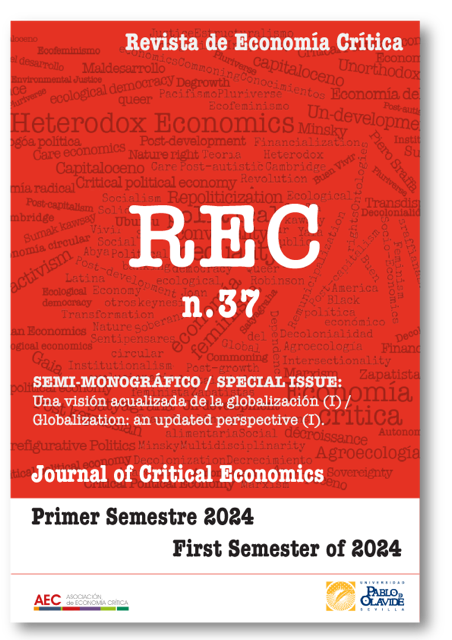Pasinetti, la economía como una estructura dinámica impulsada por el aprendizaje
DOI:
https://doi.org/10.46661/rec.10713Downloads
References
Dejuán, Óscar., & Febrero, Eladio. (2000). Measuring productivity from vertically integrated sectors. Economic Systems Research, 12(1), 65-82. https://doi.org/10.1080/095353100111281
Felipe, Jesús., & McCombie, John. (2007). Is a theory of total factor productivity really needed. Metroeconomica, 58(1), 195-229. https://doi.org/10.1111/j.1467-999X.2007.00265.x
Keynes, John M. (1936). The General Theory of Employment, Interest, and Money. London: MacMillan.
Leontief, Wassily. (1936). Quantitative input and output relations in the economic structure: an input-output approach. The Review of Economic and Statistics, 52, 262-271. https://doi.org/10.2307/1926294
Pasinetti, Luigi. (1960). A mathematical formulation of the Ricardian system. The Review of Economic Studies, 27, 78-98. https://doi.org/10.2307/2296129
Pasinetti, Luigi. (1962). Rate of profit and income distribution in relation to the rate of economic growth. Review of Economic Studies 29, 267-279. https://doi.org/10.2307/2296303
Pasinetti, Luigi. (1966). Changes in the rate of profit and switches of techniques. The Quarterly Journal of Economics, 80, 503-17. https://doi.org/10.2307/1882911
Pasinetti, Luigi. (1973). The notion of vertical integration in economic analysis. Metroeconomica, XXV, 1-29. https://doi.org/10.1111/j.1467-999X.1973.tb00539.x
Pasinetti, Luigi. (1974). Growth And Income Distribution: Essays In Economic Theory. Cambridge: Cambridge University Press.
Pasinetti, Luigi. (1977). Lectures On The Theory Of Production. New York: Columbia University Press. https://doi.org/10.1007/978-1-349-05040-6
Pasinetti, Luigi. (1981). Structural Change And Economic Growth: A Theoretical Essay On The Dynamics Of The Wealth Of Nations. Cambridge: Cambridge University Press.
Pasinetti, Luigi. (1986). Sraffa's circular process and the concept of vertical integration. Political Economy, 2(1), 3-17.
Pasinetti, Luigi. (1988). Growing subsystems, vertically hyperintegrated sectors and the labour theory of value. Cambridge Journal of Economics, 12, 125-134. https://doi.org/10.1093/oxfordjournals.cje.a035041
Pasinetti, Luigi. (1990). Cambio técnico y sistema industrial. Revista de Economía, 4, 9-15.
Pasinetti, Luigi. (1993). Structural Economic Dynamics: Theory Of The Economic Consequences Of Human Learning. Cambridge: Cambridge University Press. https://doi.org/10.1017/CBO9780511551444
Pasinetti, Luigi. (2007). Keynes And The Cambridge Keynesians: A 'Revolution In Economics' To Be Accomplished. Cambridge: Cambridge University Press.
Pasinetti, Luigi. (2022). Structural Dynamics Versus A Macroeconomic Approach – A Final Statement. Structural Change And Economic Dynamics, 61, 559-561. https://doi.org/10.1016/j.strueco.2021.08.018
Roncaglia, Alessandro. (2019). The Age Of Fragmentation: A History Of Contemporary Economic Thought. Cambridge: Cambridge University Press. https://doi.org/10.1017/9781108777766
Schumpeter, Joseph. (1912). The Theory Of Economic Development: An Inquiry Into Profits, Capital, Credit, Interest And The Business Cycle. Cambridge, MASS: Harvard University Press (2008).
Shackle, George.L.S. (1967). The Years Of High Theory: Invention And Tradition In Economic Thought, 1936-1939. Cambridge: Cambridge University Press.
Shaikh, Anwar. (2009). Economic Policy in a Growth Context: a Classical Synthesis of Keynes and Harrod. Metroeconomica, 60(3), 455-494. https://doi.org/10.1111/j.1467-999X.2008.00347.x
Sraffa, Piero. (1960). Production Of Commodities By Means Of Commodities. Prelude To A Critique Of Economic Theory. Cambridge: Cambridge University Press.
Von Neumann, John (1945-46). A model of general equilibrium. The Review of Economic Studies, 13(1), 1-9. https://doi.org/10.2307/2296111
Walras, Leon. (1874). Eléments D'économie Politique Pure; Ou Theory De La Richesse Sociale. Lausanne: L. Corbaz.
Downloads
Published
How to Cite
Issue
Section
License
Copyright (c) 2024 Revista de Economía Crítica

This work is licensed under a Creative Commons Attribution 4.0 International License.
This licence allows third parties to share (copy and redistribute the material in any medium or format) and adapt (remix, transform and create from the material for any purpose, including commercial purposes), provided that authorship and first publication in this journal (The Journal, DOI of the work) is acknowledged, a link to the licence is provided, and it is stated whether changes have been made to the work.







